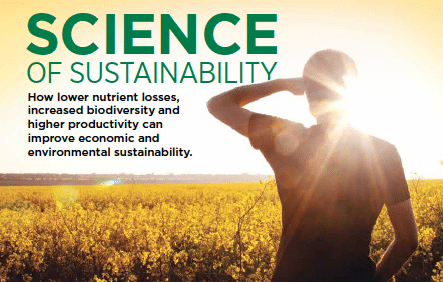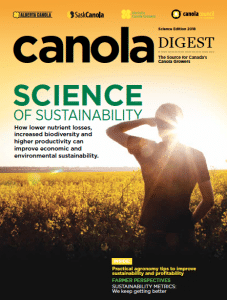Canola Digest Science Edition 2018 has a ‘sustainability’ theme and includes lots of research-based canola production tips to improve economic and environmental sustainability at the same time. Read the whole magazine online or download the PDF.
The two objectives often go hand in hand, as shown with these examples from the magazine:
A uniform early-established canola stand of six to eight plants per square foot usually yields better than thinner, later or uneven stands. It also improves nitrogen use efficiency and maintains soil organic carbon levels. It makes crop more competitive with weeds and makes it easier to time disease management applications. It makes harvest timing decisions easier. A good stand is the foundation for economic and environmental sustainability. Read more.
Target fertilizer applications to be available when the plant requires it and in a form that reduces loss to the air and water. Use of precision agriculture and data management, and increased use of fertilizer stability products will help. Increased adoption of 4R Nutrient Management guidelines will also result in improved soil and water health. Read more.
Use biodiversity to your advantage. Biodiversity of habitat across the farm can increase populations of bees and beneficials, which can increase yields and provide a natural check on insect populations. Biodiversity through crop rotations can reduce disease severity and expand management options for weeds. Read more.
Cut later to increase yields for the same inputs. A trend to delayed cutting – either through later swathing or straight combining – will increase yield over earlier cut timings. Canola Council of Canada research from the early 2000s showed that canola fields swathed at 60 per cent seed colour change (SCC) on the main stem can yield eight per cent more than fields swathed at 30 per cent SCC. The yield difference could be even higher with lower plant populations because with fewer larger plants more of the yield will be in the side branches. Read more.


